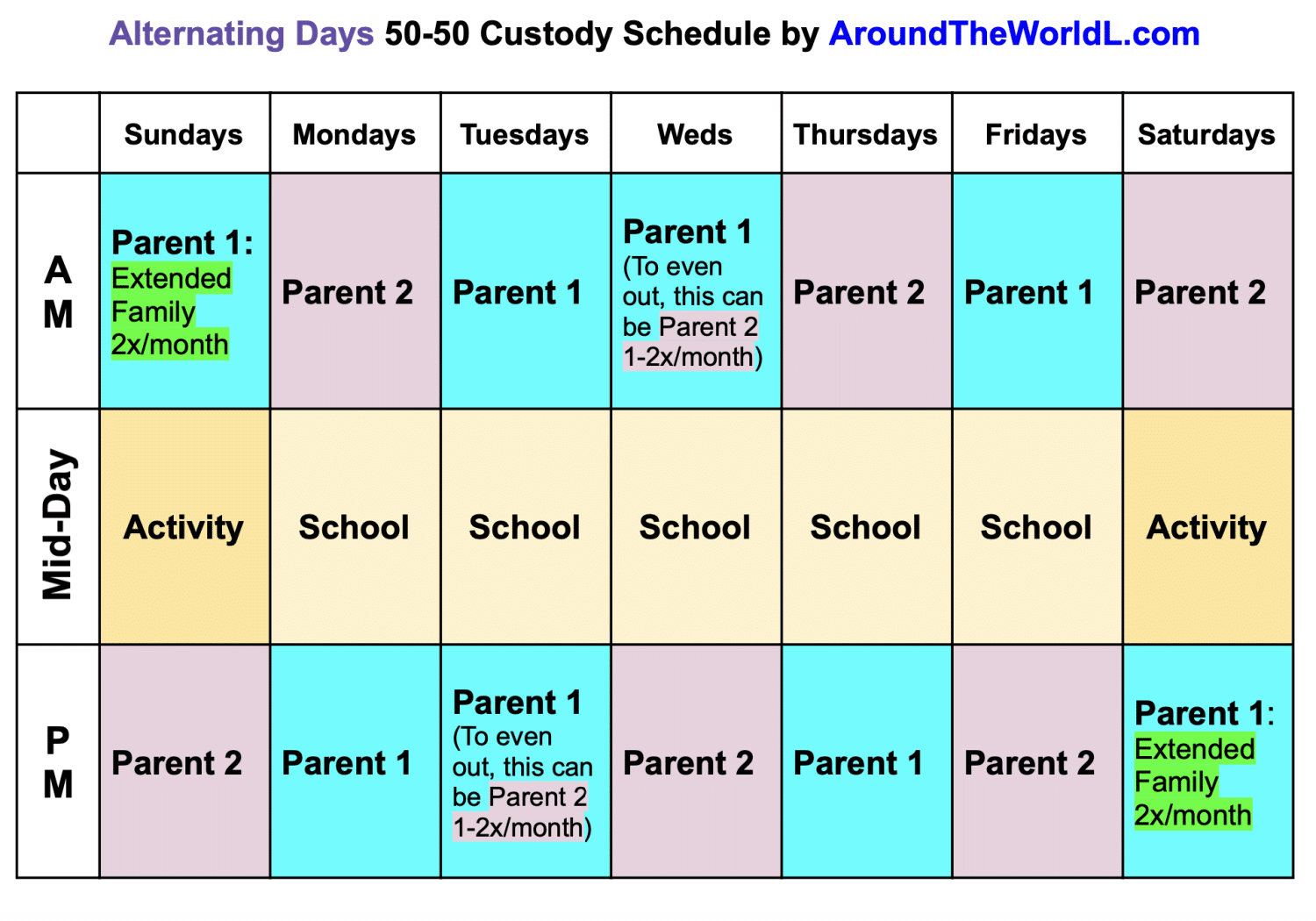When I tell people about our alternating nights child custody schedule for our two kids that my co-parent and I created after we divorced and separated into two households 1.5 years ago, they’re often surprised. People exclaim, “Your kids switch where they sleep every day? And you all love it?!”
I feel compelled to write this article because this “every other day” arrangement works VERY well for our family with elementary school-aged children. However, when we were making our 50-50 custody schedule after telling the kids about divorce, we could find almost no written examples of others doing a plan like it.
By sharing our story, I’m hoping to give another option to those looking for the best fit. This calendar set-up will not work for everyone, but it can be great for some. (Do see my co-parenting counseling article for communication tools that assist structures like this.)

50-50-Custody Schedule Goals
When you research 50-50 custody schedule options online during the divorce process, you usually find some version of alternating full weeks, half weeks, complicated two-week cycles, or — in the shortest bursts usually discussed — chunks of two to three days. However, my co-parent and I wanted to work together to craft a schedule that would have the following perks:
1. The kids get to see both parents pretty much every day.
2. Roughly the same schedule happens every week (versus complex two-week cycles), meaning, for example, the plan for Monday happens every Monday, not alternating Mondays.
3. Weekends are split between us every week (versus alternating whole weekends).
4. An equitable 50-50 ratio is achieved. (This is the hard part if you want to alternate days yet have consistent structures for each day, since there are 7 days in the week: an odd number.)
5. Most of the transitions are done via an intermediary activity (ex: school) versus needing to drive to each other’s houses.
6. Everything is organized in a clear, simple, and predictable routine with structures for communication and coordination.
Given this, we came up with the following plan:
Our Alternating Days Custody Schedule:
Mondays: C brings kids to school. L picks up.
Tuesdays: L brings kids to school. L picks up. (Note: To even this out, this evening plus Wednesday morning can be C 1-2 times a month.)
Wednesdays: L brings kids to school. C picks up.
Thursdays: C brings kids to school. L picks up.
Fridays: L brings kids to school. C picks up.
Saturdays: C brings kids to Saturday afternoon activity. L picks up; kids sleep at grandparents’ alternate weeks.
Sundays: L brings kids to Sunday morning activity. C picks up.
Here is a visual representation of what this plan looks like:

What is a Fair and Equitable Plan?
Now, you may notice that there are 4 nights with me and 3 nights with my co-parent, but we charted out the hours, and it actually comes out even as long as we add in C doing my Tuesday-Wednesday overnight once a month or so, because the kids are with him for longer stretches of waking hours due to our specific activity schedules.
For example, their Sunday morning activity ends early, so they are with him most of that day. Further, there is after-school care Tuesdays when I pick up, but not Wednesdays, when he picks up — meaning he has more hours with them Wednesdays than I do Tuesdays.
I share this detail for an important reason: Because “50-50” can look however you agree it should look, and as long as all parties find it equitable, it is. Don’t get hung up on smaller details if the wholistic package is healthy and helpful. Further, consider how activities and outside childcare support factor into the plan.
Structures to Make this Alternating Schedule Work
One of the hurtful and ignorant things that people say about divorce is that it “breaks up the family,” but a smooth 50-50 custody schedule with alternating days can very much keep the family experience intact and healthy for all involved. That said, in order for an alternating days plan like this to function smoothly, the following pieces need to be in place.
1. Collaborative and kind inter-parent communication.
Because there are numerous back-and-forth logistics with an every-other-day custody schedule, this plan usually works best with co-parents who are able and willing to be in proactive communication with a professional, generous-hearted spirit. Center creating a positive experience for the children, and it can all flow well. Both individual and co-parenting therapy can help support this, and I recommend this free service to find counselors, if you’re in MA.
2. A shared calendar and a procedure for changes.
A shared co-parenting Google Calendar is pivotal to making this plan work. Ensure that the settings have you both as full admins who can see, add, and edit any events, and that an automatic email is sent if any events are added or changed. Aim to stick to the agreed-upon schedule as rigorously as possible — at least during the school year — as predictable routine is calming and healthy, and before making any changes, send an email to the co-parent asking if they would be willing for the change to happen. (See Guideline #1 for keeping this positive.)
3. At least weekly emails with updates on the kids.
Our co-parenting counselor coached us to send at least a short summary email (not text, unless it’s time sensitive) summarizing updates about the kids from our time with them at least once a week. This is extremely useful in keeping both parents on the same page for logistical, emotional, and practical information-sharing.
4. Needed household items in both houses.
With frequent back-and-forths by the children, you’ll need both kids and adults to have all hands on deck to keep track of which items need to go where. Buying duplicates of certain items will help. For example, instead of transporting a beloved stuffed animal back and forth between houses, have two special stuffies — one in each house.
5. Geographical proximity.
If possible, living within a few miles apart makes this plan work particularly well. (As we learned in all the divorce books we read, that is a best practice in general for transitioning to two houses.) This particularly comes into play when transport to and from school involves different buses depending on which house is happening. If transport plans are different each day depending on the home the children are traveling to, make sure to loop in any teachers or administrators — providing them with a written and electronic copy of the bus/walk plan and pattern when possible to avoid confusion.
6. Village support.
Speaking of informing teachers… after deciding to get divorced and moving forward on separating into two households, update as many relevant people in you and your kids’ lives as possible, so they can support the transition and plan. For example, the parents of school friends will benefit from knowing your children stay in alternate houses each night on a set schedule, because this will assist them in knowing which of you to contact for plans. (We usually have kids’ friends’ parents contact both of us in a triple text since most days both of us are involved.)
Further, if you have beloved extended family like grandparents nearby who are willing (and even excited) to have a set time each month to do an overnight with the kids, that can also help make alternate day schedules work better. It can address the “7 is an odd number” quandary by evening out the math.
Benefits of Kids Switching Houses Each Night
I am so thankful that with this alternating days 50-50 custody schedule, my co-parent and I are able to see our kids essentially every day, even after divorce — and they’re glad to see us, too! I’m also appreciative that with this calendar, there is a comforting routine that is basically the same each week, versus a complicated two-week cycle.
50-50 Custody Schedule Thoughts?
Again, this 50-50 custody schedule of switching houses each night is not a match for every family, but as it’s worked very well for ours, I’m hoping that sharing it can offer useful ideas for some. What thoughts or questions do you have, and what experiences of your own would you like to discuss on this topic? Do share!
For further reading, browse the article called “Divorce is a Full-Time Job” that I wrote while in the thick of the year and a half it took to work through the logistical and financial aspects of separating one household into two. I’m pleased to report that now we’re in a much better place — and this alternating day custody schedule is part of what has made this next chapter work well!

The author, Lillie Marshall, is a 6-foot-tall National Board Certified Teacher of English, fitness fan, and mother of two who has been a public school educator since 2003. She launched Around the World “L” Travel and Life Blog in 2009, and over 4.2 million readers have now visited this site. Lillie also runs TeachingTraveling.com and DrawingsOf.com. Subscribe to her monthly newsletter, and follow @WorldLillie on social media!

Cassie
Friday 9th of February 2024
What a valuable resource for families. Divorce coaching for families is such a huge unmet need!
Lillie Marshall
Friday 9th of February 2024
I hope it can help those who are seeking ideas and guidance! In this series of divorce support articles, I'm basically trying to write the resources that I wish I'd had access to when I was going through the process.